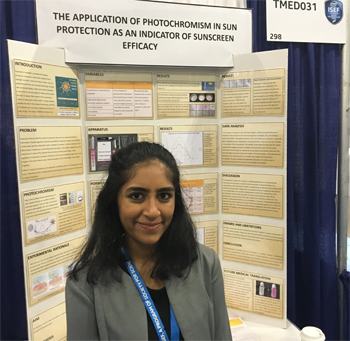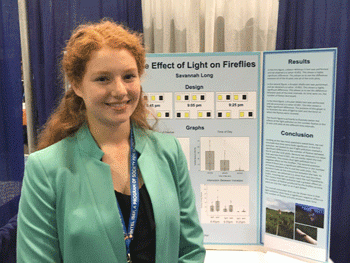Alumni, Science News for Students, Young & Amazing
Our favorite teen research stories from Science News for Students, Pt. 2
We’ve seen some incredible teen scientists in 2017. This year, Science News for Students (SNS) reported on student scientists who are creating computer programs to track space debris, mixing up a sunscreen that turns pink when you need to reapply it, and more.
Read a sampling of some of these stories from extraordinary writers Bethany Brookshire and Sid Perkins. This is Part 2 in a series, with stories from Bethany.

Tracking space debris
Amber Yang (Regeneron STS 2017, Intel ISEF 2017) developed a computer program that predicts where space trash will end up. There are more than 500,000 pieces of space trash orbiting Earth. They come from old satellites and other objects humans send into space. They can travel at more than 28,000 kilometers (17,500 miles) per hour, which is why even tiny flecks of dust can harm spacecraft. Her program might even, one day, help space travelers avoid space trash crashes.

“Smart” sunscreen lets you know when to reapply
Farah Shaik (Intel ISEF 2017), who lives in South Africa, was tired of being burned by the sun too many times. So she designed an indicator to signal when sunscreen gets thin. Her reapplication reminder turns pink to remind a person they need to slather on more sunscreen. She was inspired by an old arts and crafts project — her father had bought her some photochromic beads that are white indoors but turn vivid colors in the sun. Farah bought a small amount of spiropyran, a photochromic chemical. She consulted with dermatologists as she developed a mix of chemicals that would let her easily apply the powder to skin.Become a Society member to help guide more students into science fairs and STEM careers. Admin Title: cta

Eco-friendly chemical dip halts bacterial growth
Jessica Tian (Regeneron STS 2017) came up with a way to keep bacteria from growing on fabric, bandages, or food packaging. She created germ-free papers by dunking them in a special eco-friendly chemical bath. Jessica’s chemical bath leaves a germ-killing coating on cellulose (which is found in many materials). Most current methods to keep bacteria at bay on cellulose require heat and pressure, and some lead to air pollution.

The effect of light pollution on fireflies
Savannah Long (Intel ISEF 2017) found that nighttime lights can dim a firefly’s flash and may mean fewer fireflies in the future. Light pollution reduces fireflies’ mating success. Savannah found the fireflies definitely preferred the darkness. At 8:45 p.m., the dark plots she studied had twice as many flashes as lit plots. By 9:05 p.m., the dark plots had four times as many flashes as the brighter areas, and by 9:25 p.m., the dark plots had eight times as many flashes. Savannah said it’s just as important to look at sensory pollution like light and sound than air and water pollution.

Converting water pollutant to plant fertilizer
Stefan Wan (Regeneron STS 2017) developed a method to soak up excess fertilizer before it can cause harm in nearby rivers and lakes. His method, which uses biochar (a type of charcoal), reduces, reuses, and recycles nutrients for plants. Stefan and three University of Florida scientists have just published the new findings in the March Journal of Industrial and Engineering Chemistry. The next test will be to see if the biochar mix works as well on farms.Read Part 1 in the series.


